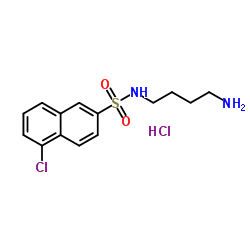N-(4-aminobutyl)-5-chloro-2-naphthalenesulfonamide hydrochloride

N-(4-aminobutyl)-5-chloro-2-naphthalenesulfonamide hydrochloride structure
|
Common Name | N-(4-aminobutyl)-5-chloro-2-naphthalenesulfonamide hydrochloride | ||
|---|---|---|---|---|
| CAS Number | 88519-57-7 | Molecular Weight | 349.276 | |
| Density | N/A | Boiling Point | 523.4ºC at 760 mmHg | |
| Molecular Formula | C14H18Cl2N2O2S | Melting Point | 241-243ºC | |
| MSDS | Chinese USA | Flash Point | 270.3ºC | |
|
Calmodulin antagonists induce cell cycle arrest and apoptosis in vitro and inhibit tumor growth in vivo in human multiple myeloma.
BMC Cancer 14 , 882, (2014) Human multiple myeloma (MM) is an incurable hematological malignancy for which novel therapeutic agents are needed. Calmodulin (CaM) antagonists have been reported to induce apoptosis and inhibit tumor cell invasion and metastasis in various tumor models. How... |
|
|
The calmodulin inhibitor CGS 9343B inhibits voltage-dependent K(+) channels in rabbit coronary arterial smooth muscle cells.
Toxicol. Appl. Pharmacol. 285 , 207-13, (2015) We investigated the effects of the calmodulin inhibitor CGS 9343B on voltage-dependent K(+) (Kv) channels using whole-cell patch clamp technique in freshly isolated rabbit coronary arterial smooth muscle cells. CGS 9343B inhibited Kv currents in a concentrati... |
|
|
Quiescence and γH2AX in neuroblastoma are regulated by ouabain/Na,K-ATPase.
Br. J. Cancer 106 , 1807-15, (2012) Cellular quiescence is a state of reversible proliferation arrest that is induced by anti-mitogenic signals. The endogenous cardiac glycoside ouabain is a specific ligand of the ubiquitous sodium pump, Na,K-ATPase, also known to regulate cell growth through u... |
|
|
CXCL12 and [N33A]CXCL12 in 5637 and HeLa cells: regulating HER1 phosphorylation via calmodulin/calcineurin.
PLoS ONE 7(4) , e34432, (2012) In the human neoplastic cell lines 5637 and HeLa, recombinant CXCL12 elicited, as expected, downstream signals via both G-protein-dependent and β-arrestin-dependent pathways responsible for inducing a rapid and a late wave, respectively, of ERK1/2 phosphoryla... |
|
|
Calmodulin activity regulates group I metabotropic glutamate receptor-mediated signal transduction and synaptic depression.
J. Neurosci. Res. 94 , 401-8, (2016) Group I metabotropic glutamate receptors (mGluR), including mGluR1 and mGluR 5 (mGluR1/5), are coupled to Gq and modulate activity-dependent synaptic plasticity. Direct activation of mGluR1/5 causes protein translation-dependent long-term depression (LTD). Al... |
|
|
A clathrin-dependent pathway leads to KRas signaling on late endosomes en route to lysosomes.
J. Cell Biol. 184 , 863-79, (2009) Ras proteins are small guanosine triphosphatases involved in the regulation of important cellular functions such as proliferation, differentiation, and apoptosis. Understanding the intracellular trafficking of Ras proteins is crucial to identify novel Ras sig... |
|
|
Prevalence of bortezomib-resistant constitutive NF-kappaB activity in mantle cell lymphoma.
Mol. Cancer 7 , 40, (2008) The proteasome inhibitor bortezomib can inhibit activation of the transcription factor NF-kappaB, a mechanism implicated in its anti-neoplastic effects observed in mantle cell lymphoma (MCL). However, NF-kappaB can be activated through many distinct mechanism... |
|
|
Ras and calcium signaling pathways converge at Raf1 via the Shoc2 scaffold protein.
Mol. Biol. Cell 21 , 1088-96, (2010) Situated downstream of Ras is a key signaling molecule, Raf1. Increase in Ca(2+) concentration has been shown to modulate the Ras-dependent activation of Raf1; however, the mechanism underlying this effect remains elusive. Here, to characterize the role of Ca... |
|
|
TOR regulates cell death induced by telomere dysfunction in budding yeast.
PLoS ONE 3 , e3520, (2008) Telomere dysfunction is known to induce growth arrest (senescence) and cell death. However, the regulation of the senescence-death process is poorly understood. Here using a yeast dysfunctional telomere model cdc13-1, which carries a temperature sensitive-mut... |